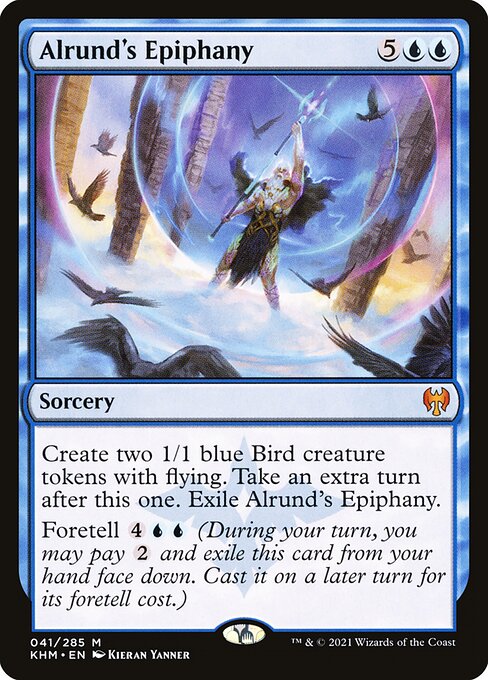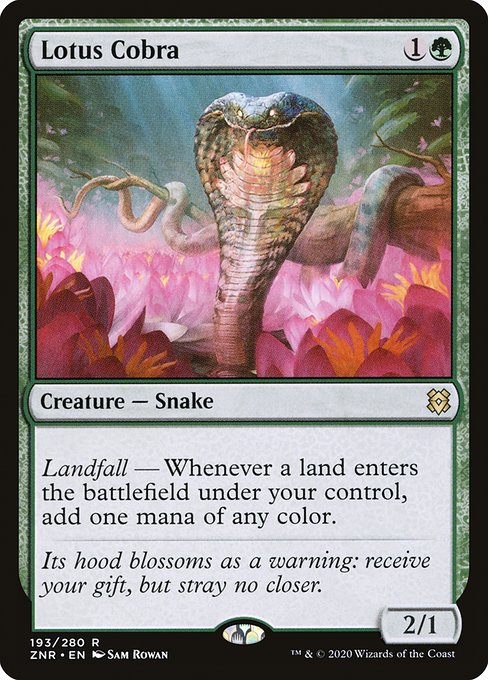Cover image: Storm the Festival by Yigit Koroglu
Eldraine, Ikoria, are Theros are in the rearview. The new post-rotation Standard metagame rests of a foundation of Alrund’s Epiphany, Esika’s Chariot, and Wrenn and Seven, balanced by Blood on the Snow and Memory Deluge. That’s an upgrade from where we were last month, either in Standard FNM matches or in Standard 2022 queues.
Of course, we already hear grumbling about the latest game-crushing Planeswalker. I get that: the line of play of “turn four Chariot, turn five Wrenn for a Treefolk, Crew Chariot, copy Treefolk” is pretty hard to come back from (although Pithing Needle and Sphere of Annihilation in the sideboard do a fair amount of work). Alrund’s Epiphany is a more difficult card to interact with, especially with Foretell backed up with counters, and it leads to pretty stagnant game states, but at least the game ends in relatively short order on the wings of Iymrith, Desert Doom or Goldspan Dragon.

Day one, I tried out a Blue-Black Zombie aggro deck replete with Tainted Adversary, Champion of the Perished, etc., but got lost in the woods immediately. It’s hard to force a Champion past a stack of 8/8 Treefolk and Decayed tokens are only useful as sacrificial lambs, without too much to sacrifice them to. While I think the deck may have potential in the future, we’re missing some tools.
I’m pretty sure Black-Green “Rock” style decks are back, although I say that with the release of every new set. Binding the Old Gods and Sarulf, Realm Eater accompanied by a healthy amount of sideboard bullets and undercosted beaters allow you to run your own Chariot and Wrenn core. The format has slowed down a bit and cards that allow you to squeeze multiple cards worth of value are even more important, so I’m looking to Sagas and Titan-style threats. Then again, I’m a Platinum bracket player, who gets bored of the Standard gauntlet and starts brewing, losing three ranks in an evening of “how can we break Jadar?” sessions.

Putting aside personal hobbyhorses and nostalgic homebrewing, we can look to the actual heavy hitters. Since Midnight Hunt dropped in late September, the metagame has settled into: Izzet Dragons, Bant Storm the Festival decks, Mono-Green Stompy, Blue-Based Control (Alrund’s Epiphany, Memory Deluge), and Black-Based Midrange/Sac Synergy. You’ll see other decks—R/G Werewolves, various Ramp strategies—but the commonality between two of the top-tier archetypes and the Tier 2 decks is still Wrenn and Seven. If you’re not running Alrund’s Epiphany, the Wrenn duo, or Lolth, Spider Queen, you’d better have a good reason.
Stompy is keeping the format honest by attacking for six or more on turns four through seven. If you can’t beat the curve of Ranger Class into Werewolf Pack Leader into Old-Growth Troll, you can’t compete—particularly when they’re backed up by the precision and potency of Blizzard Brawl. There’s no omnipresent Red aggro deck for once, although I’ve seen some attempts at Goblins, and the mono-White aggro deck doesn’t really come together often. Luminarch Aspirant is quite a card, but it dies to the splash damage of commonly-played maindeck cards.

With Bonecrusher Giant gone, fragile ramp creatures are back in full force. Prosperous Innkeeper, Tangled Florahedron, or Lotus Cobra ramps you to Esika’s Chariot or Binding the Old Gods mana on turn three and/or a Wrenn or Lolth on turn four, so you need turn two interaction. Wrenn and Seven is very good, but I think you should expect to be rewarded for landing a five-mana Planeswalker. Esika’s Chariot into Wrenn sets a good benchmark for “can my deck beat this?” in deckbuilding, and they are weak to sweepers or to sideboard champion Tempted by the Oriq stealing a huge token.
That fairness test is a good one—Standard is healthy when the games end with interactive threats. Right now, the two most dominant cards are a five mana Planeswalker and a seven mana (six with some set up) Time Walk. While it can be frustrating to lose to Wrenn or Dragon beatdown repeatedly, games are lasting longer and more swung by individual decisions, and that’s a win. That said, there are some new rules to learn in this wild world.

First off, as noted above, you need to be able to kill a Lotus Cobra or Tangled Florahedron on turn two. This I why I prefer Prosperous Innkeeper—I’d much rather have Lotus Petal than Birds of Paradise in most cases. Infernal Grasp can be awkward, but it’s a great catchall. If you’re running red, Play with Fire packs the most punch in our post-adventure world.
The next essential piece of interaction is Field of Ruin. While we’re not seeing The Book of Exalted Deeds plus Faceless Haven combo much, people are getting very greedy with the Adventures in the Forgotten Realms creature lands. Being able to hit Hall of Storm Giants or Lair of the Hydra at instant speed is imperative.
Graveyard removal is at a premium. I expect the standing of Callous Bloodmage and Immersturm Predator to rise with Crimson Vow; Froghemoth may be worth another look, as may Graveyard Trespasser. It’s also helpful to not let creatures actually die; instead, I’ve been having a lot of luck with Valentin, Dean of the Vein—he comes down early, hits for a few damage, and then cuts out Eyetwitch or Meathook Massacre shenanigans. I’m also running Sphere of Annihilation as a sideboard tool—it may not be Pernicious Deed, but it does double duty as a flexible sweeper and graveyard skimmer.

For the most part, I support how the metagame is shaping up, with one notable exception. Storm the Festival is seeing a fair amount of success, but my experiences have been pretty negative. Spending six mana for a sorcery to spit out two snow-covered lands isn’t exactly Collected Company. Pulling it off on turn four or five and snagging Wrenn and Teferi is, of course, unbeatable; but there’s too much variance for me to trust it. I’ve seen too many fives along the lines of two lands, Florahedron, Innkeeper, and Wrenn.
From the success of two-color archetypes and even mono-color decks, we can see the weakness of Standard’s new manabase. Pathways are great, but their inability to tap for multiple colors of mana restrict their usefulness; the Snarls are abominable—you’ll run them, but they’re effectively Guildgates. With any luck, Crimson Vow will bring the enemy equivalents of Midnight Hunt’s partylands, but until then, ally colors have a minor advantage with Pathways and Shipwreck Marsh and company. Sultai and Mardu have all the goods they need to succeed, but they’re held back by imperfect mana—something to watch with the release of Crimson Vow.
It may still be a developing format, with the latest Midnight Hunt cards overrepresented due to excitement, but Standard is more fun than it’s been for two years. The primary win conditions right now are five-drop Dragons and Planeswalkers, a cat-powered Vehicle, armies of Pest tokens, and a host of Werewolves and Trolls. Eventually, the format will stratify more concretely, and we’ll have the optimal seventy-fives; but right now, there’s flexibility and a scramble for the latest technology.
A lifelong resident of the Carolinas and a graduate of the University of North Carolina, Rob has played Magic since he picked a Darkling Stalker up off the soccer field at summer camp. He works for nonprofits as an educational strategies developer and, in his off-hours, enjoys writing fiction, playing games, and exploring new beers.

